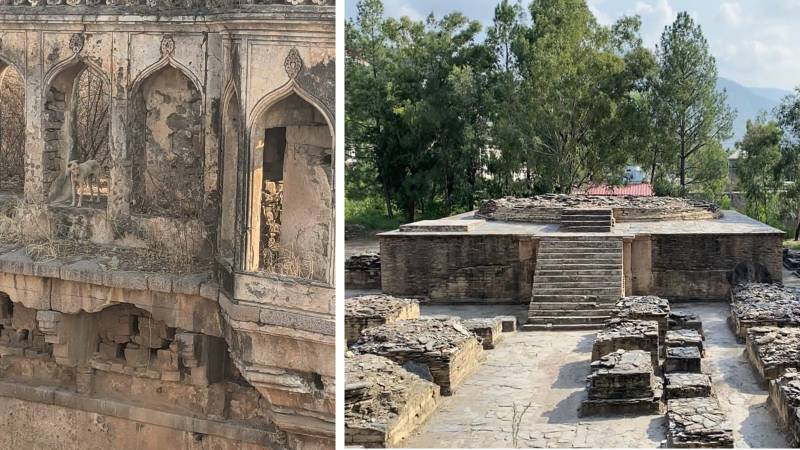
Kafiro Dherai, which falls in the district of Shangla of Pakistan, has a beautiful and relatively large-scale site of a group of Bodhisattvas and seated Buddhist carvings. However, the carvings have been recently damaged. Treasure hunters have tried to take the Buddha carving out of the boulder by drilling. It is still there, but it might soon perish if no measures of protection are taken. In a survey, the three shelters were already destroyed and there are now two shelters which are in the process of being destroyed. Kafiro Dherai is in Khyber-Pakhtunkhwa, a region full of religious archaeological sites.
Religious archaeological sites in India meet the same fate. Distinctive minarets, enchanting flowery designs, and the beautiful dome of the tomb in India’s Hyderabad city are a testimony of past glory. However, bushes and trees have grown over the dome, roots spread inside walls, cattle entering this dilapidated structure, and people spitting on walls showcase how this rich religious heritage is neglected by the state government. This 350-year-old Qutb Shahi tomb in south Indian Telangana state is surrounded by vendors selling miscellaneous things, electric poles, and garbage heaps. One has to struggle to locate this old religious heritage structure.
However, these monuments are not unique cases of getting damaged. Hundreds of religious and other heritage monuments from both countries have been damaged, demolished or disappeared. Activists cite insufficient manpower and a lack of funds from governments – but also neglect by the local populations.
How Kafiro Dherai got damaged
According to Ijaz Hassan, a graduate archaeologist at the Directorate of Archaeology and Museums of Khyber-Pakhtunkhwa," the Kafiro Dherai archaeological site is located in the government high school area of Shangla, but unfortunately, the government has not taken care of it. There is a major issue with the site being on the road and cars are passing over it, which is causing damage and accidents. The site is very important and should be protected." The archaeological site in Shangla dates back to the Gandhara civilisation (1st century AD).
Ijaz Hassan says: “The Kafiro Dherai archaeological site is a Buddhist heritage site, in ruined condition, consisting of a stupa of considerable height, completely devastated from the centre. The sides of the stupa including the base have been badly ruined. The site was discovered in 2001, and it is a significant cultural heritage site but the biggest reason it is being damaged is that local people think there is a treasure buried here. So they try to dig it up, sometimes during the day but mostly at night, causing harm to the ancient site. Whether they find the treasure or not, we will soon be deprived of this historical place."
Hassan further adds: “This is a common problem at many historical sites, where locals or treasure hunters may believe that there is valuable treasure buried there, leading to illegal digging and damage to the site.“
Qutb Shahi tomb in India’s Hyderabad remains neglected
The Department of Archaeology and Museums of Telangana state has the responsibility to maintain and conserve the structure. However, apart from the board explaining the name and short history, there is no sign that the structure is protected. No security is posted. Since the structure is listed as a heritage site, people are not allowed to offer prayers.
This tomb is of Aga Khundmir, a tutor of one of the daughters of the Qutb Shahi King, who ruled the city from the dynasty of that name from 1518 to 1687 AD.
Pakistan’s Khyber-Pakhtunkhwa is replete with religious heritage sites
In Pakistan, the Directorate of Archaeology has registered 6,828 sites in Khyber-Pakhtunkhwa. But there are still unexplored areas in Khyber-Pakhtunkhwa, including the areas of Waziristan, Bajaur, Swat Laki Marwat, Upper Kohistan, Lower Kohistan Chitral and others. We will work on them in future. According to the data, Khyber-Pakhtunkhwa has up to 20 thousand archaeological sites.
Unfortunately due to fear and security reasons, minority communities are not going for worship. The government of Pakistan is not serious about taking care of these hundreds and thousands of years old religious archaeological places.
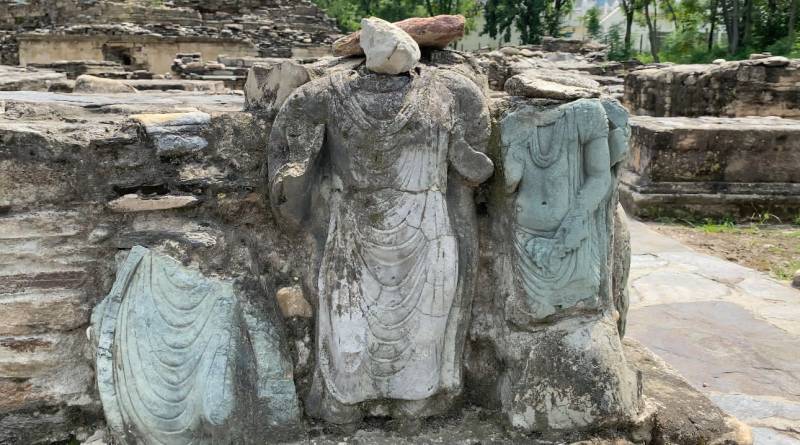
Khyber-Pakhtunkhwa has been the historic gateway to South Asia and was once the cradle of different civilisations. Buddhism, Gandhara, Hindu, Mauryan Empire, Alexander the Great's invasion, Indo-Greeks, Indo-Scythians, Indo-Parthians, Kushan Empire, Turk Shahis, Sikh Empire, British Empire, and others were in the Peshawar Valley, and included the hilly areas of Swat, and Dir, extending in the east to the Indus River and Taxila. The Khyber Pass has always been the route between Peshawar and Afghanistan.
The province has six thousand and 828 archaeological sites in Khyber-Pakhtunkhwa, but the number of staff available to explore these is far from enough, according to the directorate’s top official.
According to the Department of Archaeology KhyberPakhtunkhwa, during the past five years – from 2019 to 2023 – a total of 113 historical buildings, stupas, artefacts, ancient structures, bridges, cemeteries, shrines and other cultural heritage sites have been damaged in Khyber-Pakhtunkhwa. This damage has been reported in various districts, including Peshawar, Khyber District, Dera Ismail Khan, Swat, Nowshera, Charsadda, Mardan, and others where historical sites are present.
India’s rich heritage structures getting damaged
However, the tomb is not the only structure that is decaying, damaged, or disappeared due to neglect by concerned government authorities. A lack of funds for conservation, and apathy by the general public to protect the structures have meant that many religious and heritage sites are getting damaged. In the worst cases, they are disappearing.
Plaster from walls and roofs is coming out, bricks and stones of walls are falling, and people are throwing garbage at these sites. The condition of the Qutb Shahi mosque in Khairatabad is typical of such a story. The beautifully built mosque is in a dilapidated condition, though this is also a protected site. Hyderabad city alone has over 130 heritage sites of state- or national-level importance. According to heritage activists, at least 10 of the monuments have already disappeared or been encroached upon. And the government has no idea about it.
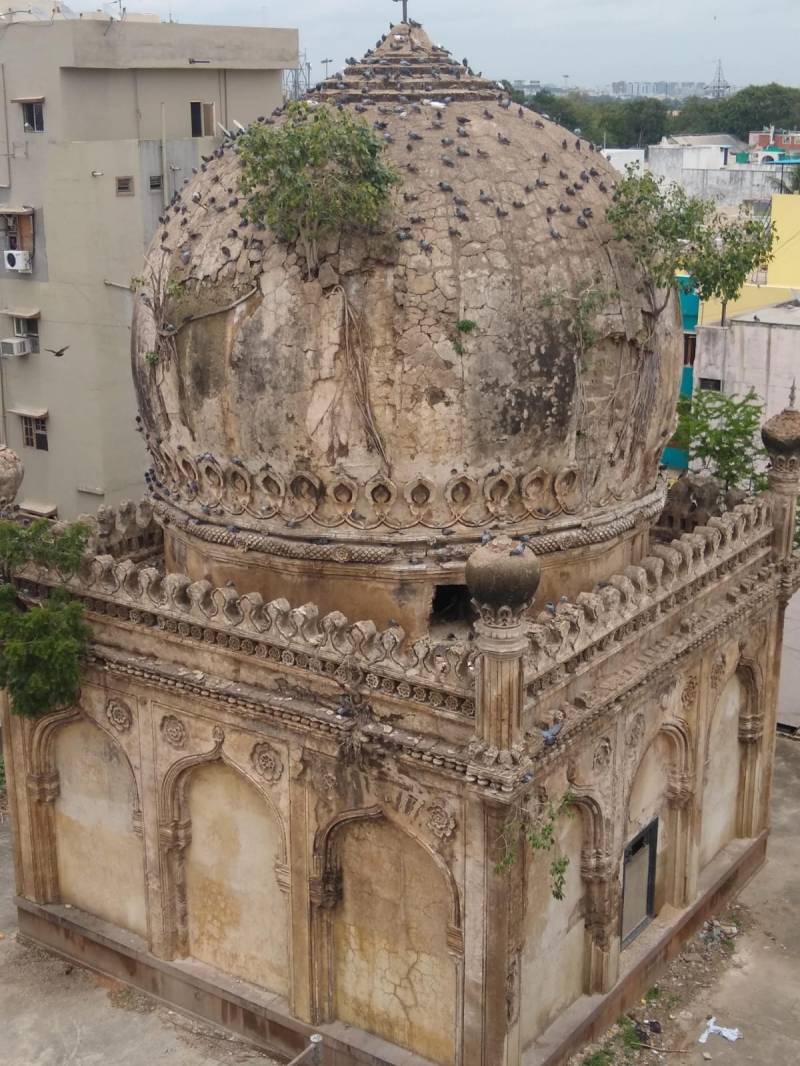
Many of them are owned by private entities. Privately owned heritage structures like Khusro Manzil have been razed to the ground for land value. The building near Lakdi-ka-Pul was a grade III heritage structure.
Hyderabad city was founded and ruled by the Qutb Shahi dynasty, during the 16th and 17th centuries. Later it was ruled by the Mughals, Nizams, and British. No wonder the city has hundreds of religious and other heritage monuments.
Anuradha Reddy, convenor of the Hyderabad chapter of the Indian National Trust for Art and Cultural Heritage, points out that governments need to have the intention to protect heritage in the first place
In the same way, India is rich with thousands of religious and other heritage monuments of national importance including 42 World Heritage Sites. The Archaeological Survey of India (ASI), the body under the Ministry of Culture of India, is responsible for the research, conservation and preservation of heritage sites that are nationally important through the Ancient Monuments and Archaeological Sites and Remains Act, 1958 (24 of 1958) (AMASR Act). ASI protects 3,693 monuments across India.
Archaeology departments of states through their laws look after heritage sites that are important for respective states. India has 4,508 state-protected monuments.
Three Haibagaram Malakand Stupas cleared away
The Malakand district is blessed with beautiful and archaeological sites. It was once an important centre of Gandhara and Buddhist civilisation, but unfortunately, many of its historical sites are being destroyed. The areas of Hantigram, Alla Dhond Dheri, Zulam Kot, Luriano Tangi, Pali, Gandiar, Nilon, Dargai, and Shah Kot are all rich in ancient artifacts, but unfortunately, people have caused irreparable damage to these sites.
The stupa was in Haibagaram village approximately three kilometres away from the main GT road of Malakand district.
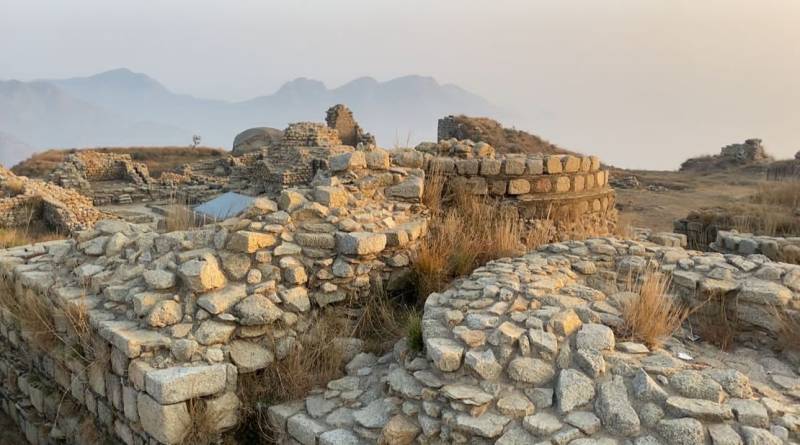
Local visitor Fazal Mabood says: “I am coming here for the last 40 years. But last year, someone cleared the famous three stupa of Haibagaram. Now there is no stupa and everything is washed fully. There is just a flat surface now. There is a famous stupa which has a circle and a remarkable shape. But the stupa was damaged first by the earthquake and then the stupa was fully cleared by the locals through excavators. The stupa walls were made up of unique stones and clay. I am working in Saudi Arabia, and when I visit Pakistan, I am trying to explore the archaeological sites of Khyber-Pakhtunkhwa. But unfortunately, these sites are being lost day by day. I requested the government to pay a little attention to this matter, because if it had intervened earlier, precious national assets would not have come to such tragic ends.”
According to the ex-Curator of Swat Museum Abdul Nasir:
“I was here, and there was not only one stupa but in fact two. This was before unknown people cleared them. The sites were considered to be among the best examples of stupas, but unfortunately, no one paid attention to them. When I was posted in the Swat Museum, there was a watchman on the Batagram Stupa and Ganya Stupa. This was a reason that the stupas were safe. Later the watchman was called back by the Swat Museum. Obviously, historical sites are destroyed if there is no one to care about them.”
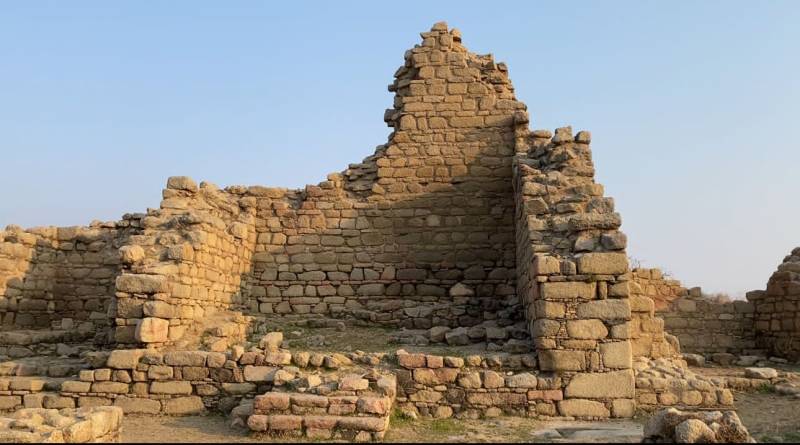
Abdul Nasir continues:
“Swat was fortunate to have been visited by Italian Professor Giuseppe Tucci in 1954, who worked with scholars and professors to preserve the ancient artifacts. However, no such efforts have been made in Malakand. Many stupas, including the Hantigram Stupa, Alla Dhond Dheri Stupa and Shah Kot Stupa, have been damaged, and local people have erased their names and signs.” Despite our efforts to alert the provincial government and archaeology department, they have not taken any serious action to preserve these historical sites.
“During my time at the Swat Museum, I tried my best to protect these artifacts, but unfortunately, they were eventually destroyed. It is a shame that the authorities are not taking any action to preserve these historical sites, which are being destroyed one by one. We still have many archaeological sites here that are not being taken care of, and if the government does not conduct a scientific survey to identify and preserve them, they will be lost forever.”
Abdul Nasir further adds: “A mafia is involved in the destruction of these sites, and they are only interested in making money. If we inform the local police, they do not take any action because they are also interested in making money. The archaeology department is also not doing anything to preserve these sites. It is a shame that these archaeological sites are being destroyed, and if we do not take action, they will be lost forever."
Government apathy in both India and Pakistan
Bakht Muhammad is Curator Directorate of Archaeology and Museums of Khyber-Pakhtunkhwa. He explains:
“The Directorate of Archaeology has registered 6,828 sites in Khyber-Pakhtunkhwa. But there are still unexplored areas in the province, including the areas of Waziristan, Bajaur, Swat, Lakki Marwat, Upper Kohistan, Lower Kohistan, Chitral and others. We will work on them in future. According to the data, Khyber-Pakhtunkhwa has up to 20,000 archaeological sites. Unfortunately, we don't have any specific funds from the provincial government. If we identify sites then we will fill a PC1 form in the urgent phase [Planning Commission Form -I, a project document describing the need for the project, its description, justification, location, duration, cost estimates and the tangible/non tangible benefits associated with it] and we work on the sites, and then the provincial government will release a fund for these new sites.”
Bakht Muhammad insists:
“All the archaeological sites in Khyber-Pakhtunkhwa are important to us. In fact, they are important not only for Khyber-Pakhtunkhwa but all of Pakistan. It is our responsibility to protect these sites. Unfortunately, unknown people indeed do illegal activities. We arrest people and prosecute them because they are harming our assets. The provincial government has decided to promote religious tourism, including for Buddhist visitors, in Khyber-Pakhtunkhwa. The government also arranges seminars and conferences in various endowments to create awareness among the people.”
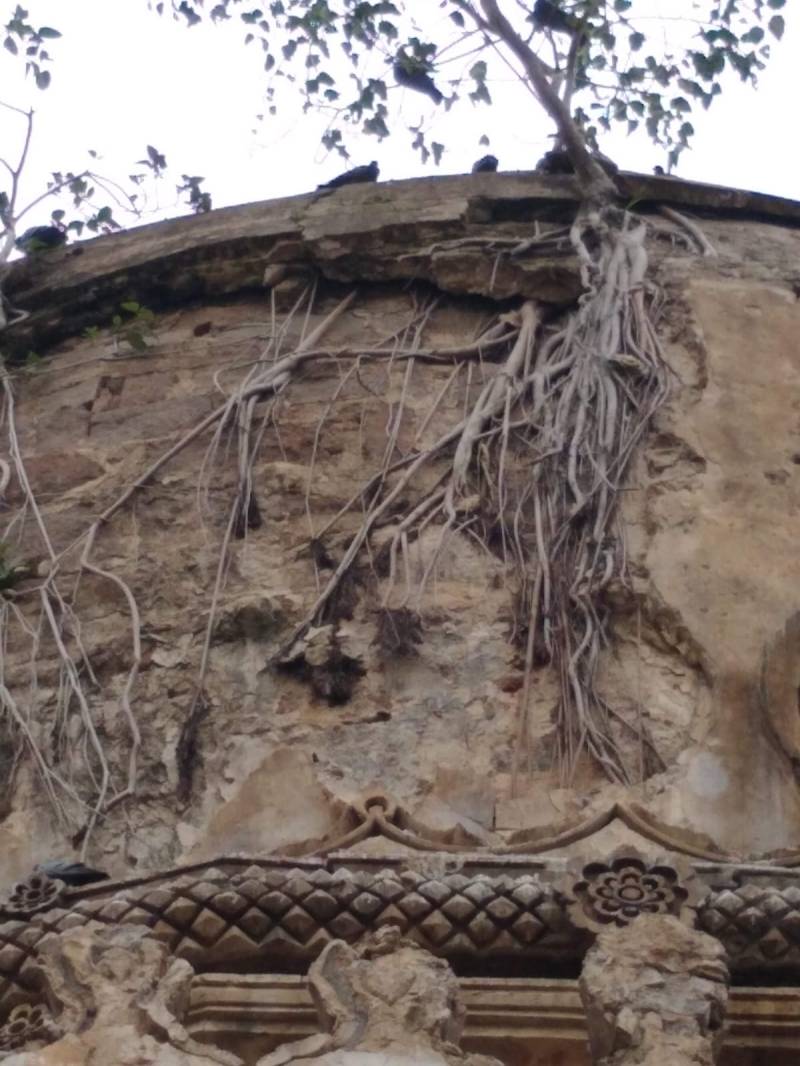
About the government’s vision, he explains:
“We welcome people of different religions to Khyber-Pakhtunkhwa because we have the world's largest collection from Gandhara. There is peace now in Khyber-Pakhtunkhwa. People from China, Sri Lanka, Malaysia, Nepal, South Korea and other countries come here and engage in devotional activities. Earlier, there used to be more concern due to the security situation. Now the situation of peace is normal. Previously, there was a condition of obtaining NOC [No Objection Certificate] for foreign tourists. This condition has also been eliminated. Now tourists from across the world come here for religious heritage or scholarly reasons.”
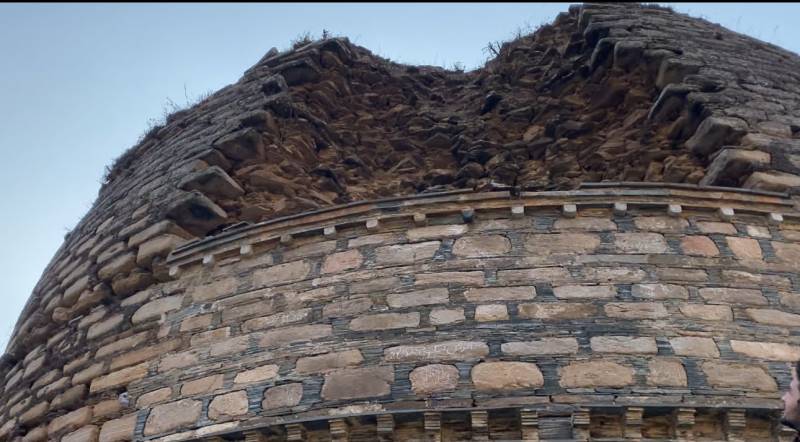
He then mentions the governmental response to reports of damage to such sites:
“In response to these allegations, complaints were filed against more than 107 suspects in various police stations. The Department of Archaeology has registered FIRs against 39 of these suspects under the Antiquities Act. However, no charges have been formally filed against anyone, and no one has been sent to jail.” Most of these cases have been filed against the demolition of historical buildings. Mardan, Swabi, Swat, Mansehra, Charsadda and Haripur are particularly notable, with cases registered against six individuals.”
ASI could not trace monuments under its protection
Recently in March 2024, India’s Ministry of Culture delisted 18 heritage structures, saying they ceased to be of national importance. In January 2023, ASI told India’s parliament that 50 monuments out of 3,693 protected monuments had disappeared. The 18 delisted monuments are from this list of 50 disappeared monuments.
Explaining why monuments were delisted, a spokesperson of ASI says that monuments get damaged sometimes due to urbanisation, heavy rainfall, overgrowth of vegetation or vandalism. And sometimes rivers change their course, leading to sites being submerged. In such cases monuments are delisted.
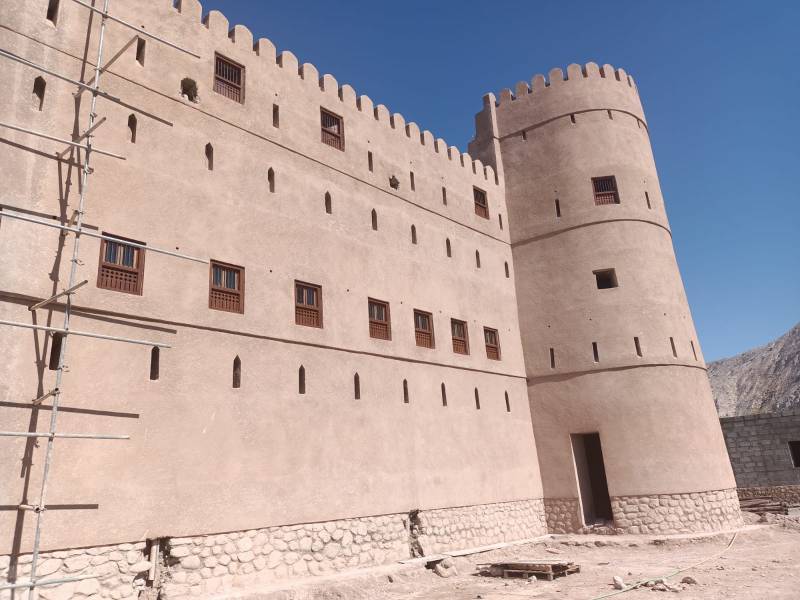
One of the delisted monuments is Barakhamba Cemetery in Delhi, capital of India. Barakhamba, which means “12 pillars,” is a 14th-century tomb from the Tughlaq period. This tomb has been untraceable for years. As per experts, monuments get encroached on or disappear due to rapid urbanisation, or else they get submerged in reservoirs or dams.
In the same way, many state heritage sites have disappeared, been damaged and encroached upon.
“There is a conflict between heritage and development. For example, if private entities own heritage sites, and don’t have enough money to maintain the property. Government agencies don’t have funds to protect private properties. Owners are more interested in the land value of the property. Thus they demolish properties for commercial reasons,” says archaeologist Sanjay Deshpande.
For example, Khusro Manzil was demolished by its owners. It was the home of Jung Bahadur, chief commanding officer of the Nizam’s army.
“Due to a lack of sufficient manpower, and funds and apathy by agencies, many religious and other heritage sites of national and state importance have disappeared or are being damaged,” Mohamed Safiullah, heritage activist says.
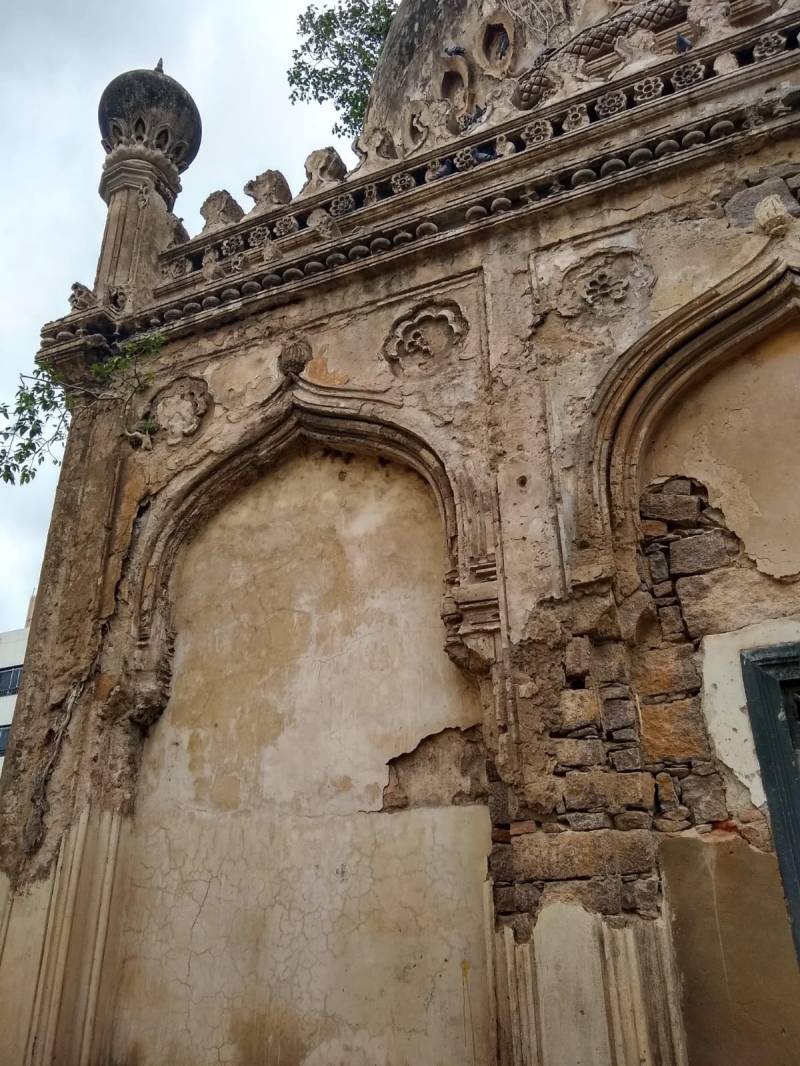
“People who own structures should take pride in their heritage. Besides, the government should offer incentives like concessions in taxes or electricity bills for people to protect these monuments. However, since the land value of these places has gone up, people are more interested in money,” says Mohammed Safiullah, a heritage activist from Hyderabad.
Experts point out that ASI and state archaeology departments have manpower in a few hundreds, while the number of heritage monuments is in the thousands. That means there is not enough manpower to protect and conserve heritage sites. ASI receives funds of around Rs 1,102 crore ($121 million). But most of the funds go into staff salaries, leaving little for protection and conservation of monuments. An ASI spokesperson said a total of Rs 75 crores ($9.1 million) are spent on protection and conservation of monuments.
Anuradha Reddy, convenor of the Hyderabad chapter of the Indian National Trust for Art and Cultural Heritage, points out that governments need to have the intention to protect heritage in the first place. “Earlier, the government in Telangana state had not allocated enough funds to protect the rich heritage of the city, causing a couple of structures to be demolished. There were not enough funds, manpower, and security. Thankfully the current government has promised the protection of heritage in its manifesto. For instance, it has promised to preserve Osmania General Hospital, a structure built during Nizam’s rule.”
Nevertheless, an activist says on condition of anonymity that the central government is not sufficiently interested in the protection of monuments of national importance.
The search for solutions
Experts say that under a Corporate Social Responsibility (CSR) approach, the government could ask corporations to adopt a monument to conserve, so that there will be no issue with funding. Corporations can easily spend millions on conservation. Currently, the Red Fort and a couple of monuments are being taken care of by a private company under the ‘Adopt a Heritage Structure’ scheme.
Experts also suggest heritage structures can be integrated into tourist culture centres and thus revenue earned from sales can be used to maintain them.

